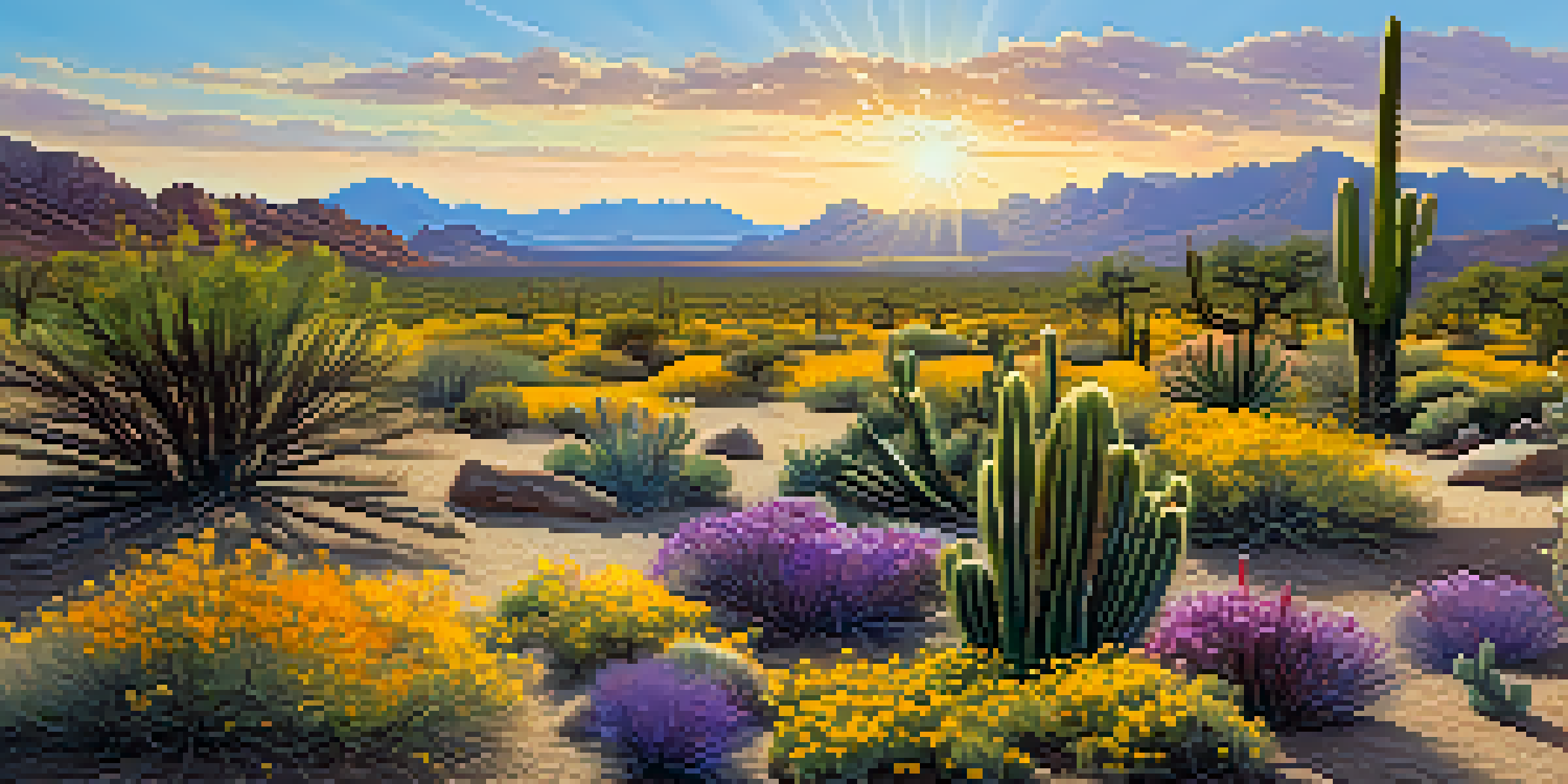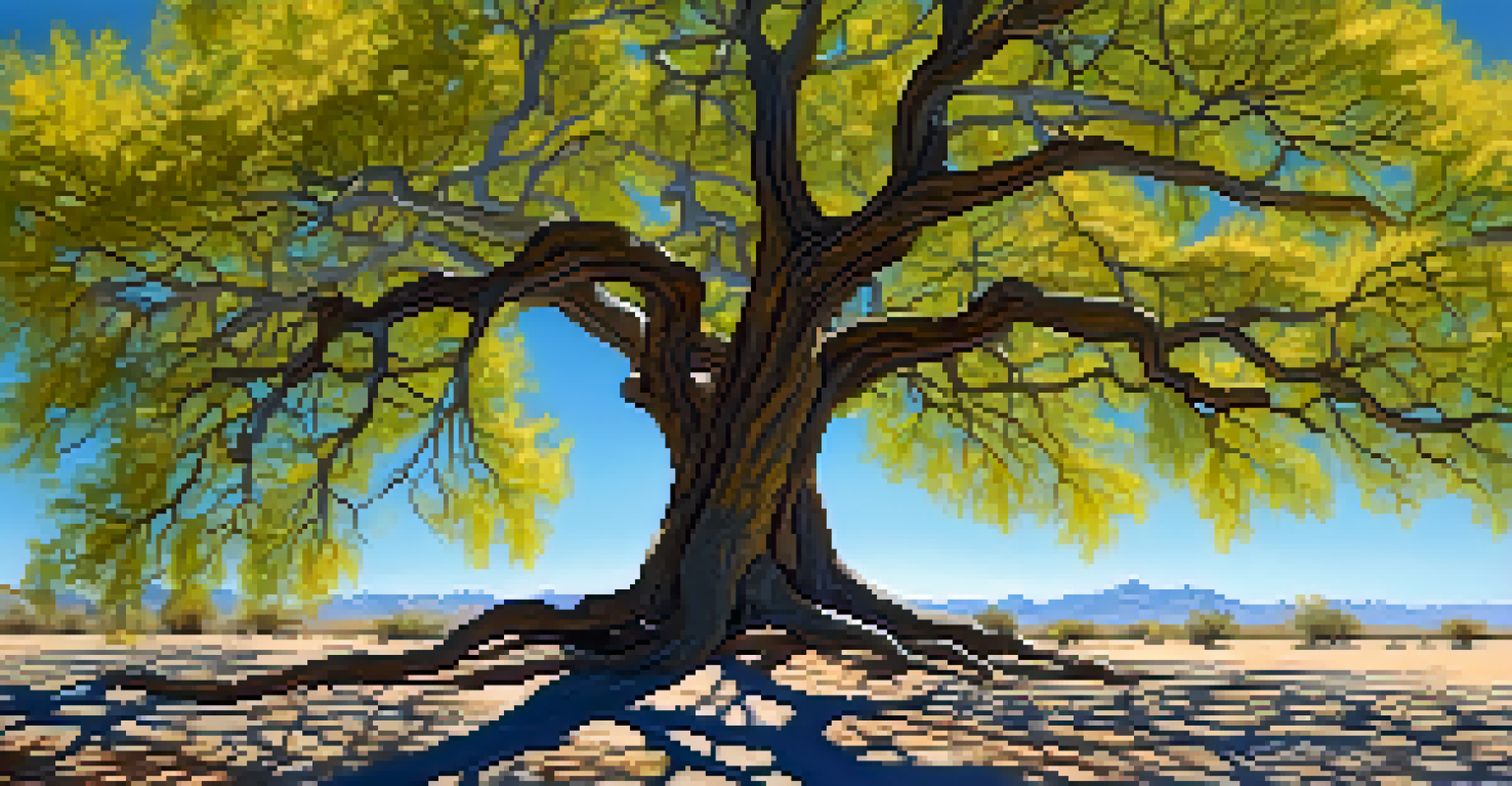Exploring the Unique Flora of the Sonoran Desert Ecosystem

Introduction to the Sonoran Desert's Ecosystem
The Sonoran Desert, stretching across parts of Arizona, California, and Mexico, is a stunning example of biodiversity. This unique ecosystem is characterized by its arid climate, which can lead many to believe that plant life is sparse. However, a closer look reveals a rich tapestry of flora that has adapted to survive in such harsh conditions. From towering cacti to vibrant wildflowers, the Sonoran Desert showcases nature's resilience and creativity.
The desert is a natural extension of the sea. It is a land of great beauty, great solitude, and great peace.
One of the most fascinating aspects of this desert is its seasonal changes. During the spring, the landscape bursts into color as wildflowers bloom, creating a vivid contrast against the brown earth. These seasonal adaptations highlight how plants have evolved to take advantage of fleeting moments of rainfall. By understanding these cycles, we can appreciate the intricate balance of life in this ecosystem.
In this article, we will explore some of the most iconic and unique plants of the Sonoran Desert, delving into their adaptations, ecological roles, and the beauty they contribute to this harsh yet alluring environment.
The Iconic Saguaro Cactus: A Desert Giant
The Saguaro cactus is perhaps the most recognizable symbol of the Sonoran Desert. Standing tall and majestic, these cacti can grow up to 40 feet high and live for over 150 years. Their iconic arms stretch outwards, creating a silhouette that is instantly associated with the American Southwest. Beyond their impressive stature, Saguaros play a vital role in the desert ecosystem, providing habitat and food for various wildlife.

One of the most remarkable features of the Saguaro is its ability to store water. During the rainy season, it can absorb and retain thousands of gallons of water, allowing it to survive long periods of drought. This adaptation is crucial, not only for the cactus itself but also for the animals that depend on it for sustenance. The Saguaro's sweet fruit, which ripens in June, attracts birds and mammals, further intertwining its fate with the desert's ecosystem.
Biodiversity in the Sonoran Desert
The Sonoran Desert hosts a diverse range of plants, each uniquely adapted to survive in its arid conditions.
Caring for these giants is essential, as they are vulnerable to environmental changes and human activity. Understanding the significance of the Saguaro helps us appreciate the delicate balance of life in the Sonoran Desert and the importance of preserving this unique habitat.
The Resilient Creosote Bush: Nature's Survivor
The Creosote bush is another remarkable plant that thrives in the Sonoran Desert. Known for its distinctive smell, especially after rain, this hardy shrub can live for over 11,000 years, making it one of the oldest living organisms on Earth. Its leaves have a waxy coating, which minimizes water loss, allowing it to withstand extreme drought conditions. This adaptation showcases nature's ingenuity in surviving the desert's challenges.
In every walk with nature one receives far more than he seeks.
Creosote bushes play a crucial role in their environment by stabilizing soil and preventing erosion. Their deep roots help in water absorption, which benefits surrounding plants. Additionally, the bush provides shelter and food for various desert creatures, illustrating how interconnected life is in this ecosystem. It's fascinating to see how one plant can contribute significantly to the health of its surroundings.
Moreover, these bushes have a unique relationship with the desert rain cycle. When it rains, they release a chemical that helps inhibit the growth of nearby plants, reducing competition for resources. This fascinating survival strategy highlights the complex dynamics at play in the Sonoran Desert, emphasizing the importance of each species within the ecosystem.
The Vibrant Ocotillo: A Desert Flame
The Ocotillo, with its tall, spindly stalks and vibrant red flowers, is a striking addition to the Sonoran Desert landscape. Often mistaken for a cactus, this plant is actually a deciduous shrub that thrives in arid conditions. Its unique ability to lose its leaves during dry spells and quickly regrow them after rain is a remarkable adaptation that helps it conserve water. This feature makes it a true symbol of resilience.
During the spring, Ocotillo blooms with clusters of bright red flowers that attract hummingbirds and bees, showcasing its role in the desert ecosystem as a pollinator's haven. These flowers not only add stunning bursts of color to the landscape but also support the delicate balance of life in the desert. The Ocotillo's blooms serve as a crucial food source for wildlife during a time when resources are often scarce.
Importance of Iconic Flora
Plants like the Saguaro cactus and Creosote bush play crucial roles in providing habitat and food for wildlife.
Additionally, the Ocotillo is an important part of the desert's cultural heritage. Indigenous peoples have long utilized its fibers for making ropes and baskets, demonstrating the plant's versatility and significance. By understanding the Ocotillo's role, we can appreciate the intricate connections between flora, fauna, and human culture in this unique ecosystem.
The Adaptations of the Palo Verde Tree
The Palo Verde tree, known for its green bark and yellow flowers, embodies the spirit of the Sonoran Desert. This tree is adept at surviving in extreme conditions, and its green bark enables it to photosynthesize even when it loses its leaves during dry seasons. This unique adaptation allows the Palo Verde to thrive in an environment where water is scarce, making it a vital source of shade and shelter for other desert inhabitants.
In addition to its remarkable adaptations, the Palo Verde tree plays an essential role in the ecosystem. Its flowers provide food for pollinators, while its pods offer nourishment for birds and small mammals. The tree also helps to improve soil quality by fixing nitrogen, enriching the ground for other plants and creating a more diverse habitat. It's fascinating how one tree can contribute so much to the well-being of its environment.
Beyond its ecological contributions, the Palo Verde tree holds cultural significance for many communities in the region. Its wood is used for crafting, and its beauty is celebrated in local art. By recognizing the importance of the Palo Verde, we deepen our understanding of the interconnectedness of nature and humanity in the Sonoran Desert.
The Delicate Beauty of Desert Wildflowers
Desert wildflowers are a breathtaking sight that transforms the Sonoran Desert during the spring months. These resilient plants, such as the California poppy and desert marigold, bloom in response to seasonal rains, creating a vibrant carpet of color across the arid landscape. Their short-lived beauty serves as a reminder of the desert's fleeting moments of abundance, captivating anyone lucky enough to witness this spectacle.
The blooms of these wildflowers are not just lovely to behold; they play a crucial role in the desert ecosystem. They provide essential nectar for pollinators like bees and butterflies, helping to sustain the delicate balance of life. Furthermore, these flowers contribute to soil health by preventing erosion and facilitating nutrient cycling, showcasing how beauty and utility often go hand in hand in nature.
Threats to Desert Ecosystems
Climate change and human activity pose significant threats to the delicate balance of life in the Sonoran Desert.
However, the survival of these wildflower populations is threatened by climate change and human activity. Understanding their life cycles and the importance of their existence can help us advocate for conservation efforts. By appreciating the delicate beauty of desert wildflowers, we can foster a deeper connection to the Sonoran Desert and its remarkable ecosystems.
The Role of Succulents in the Desert Ecosystem
Succulents are a fascinating group of plants that have evolved to store water in their leaves and stems, making them well-suited for life in the Sonoran Desert. Species like the Agave and Aloe thrive in the arid environment, showcasing a variety of shapes and sizes. These plants are not only visually striking but are also crucial players in their ecosystems, helping to maintain moisture levels and providing food for various desert animals.
The adaptations of succulents allow them to survive long periods of drought, making them a vital resource in the desert. Their fleshy leaves can store significant amounts of water, which can be utilized during dry spells. Additionally, many succulents produce flowers that attract pollinators, further highlighting their ecological importance. This intricate relationship between plants and animals demonstrates the interconnectedness of life in the desert.

Moreover, succulents have cultural significance as well. They have been used by indigenous peoples for food, medicine, and crafting, showcasing their versatility. By understanding the role of succulents in the Sonoran Desert, we can appreciate their beauty and the vital functions they serve within this unique ecosystem.
Conclusion: Preserving the Sonoran Desert's Unique Flora
The Sonoran Desert is home to a remarkable array of flora, each species playing a vital role in the overall health of the ecosystem. From the towering Saguaro cactus to the delicate desert wildflowers, each plant showcases nature's resilience and adaptability. As we have explored, these plants are not just beautiful; they are essential for sustaining the intricate web of life in this unique environment.
However, the challenges posed by climate change and human development threaten the delicate balance of this ecosystem. It's crucial for us to recognize the value of preserving these unique plant species, as they are integral to the health of not only the desert but also the planet as a whole. By advocating for conservation efforts, we can help ensure that future generations will continue to enjoy the beauty and diversity of the Sonoran Desert.
In conclusion, exploring the unique flora of the Sonoran Desert offers us a deeper understanding of the natural world and our place within it. By fostering a connection with these remarkable plants, we can inspire a greater appreciation for the importance of biodiversity and the need to protect our planet's precious ecosystems.